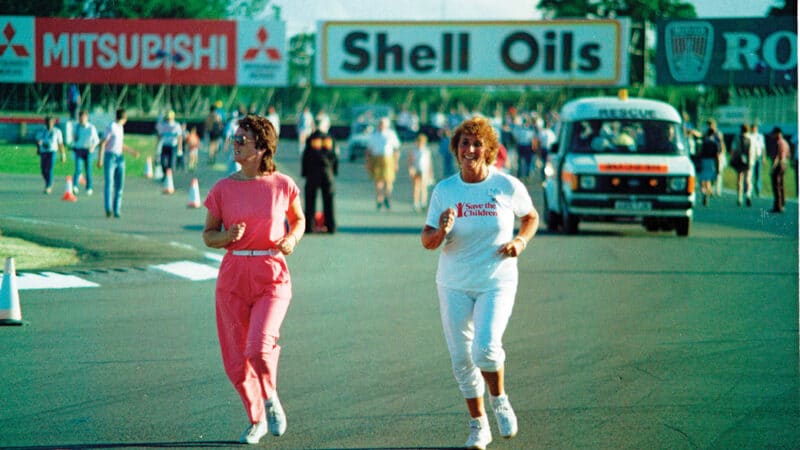Letters- January 2024

Michael Andretti has sounded out Szafnauer even before Alpine stint
Peter Bradbury
Reading Mark Hughes’s column (December 2023 issue) I become ever more incredulous regarding the apparent opposition of the 10 existing Formula 1 teams to the ambition of Michael Andretti to join the circus alongside partner General Motors. Recently I watched the Williams team principal James Vowles try to defend his outright damning of the Andretti bid by citing the fact that he was responsible to 900 employees who, as I write, create two grand prix cars for a midfield runner and back marker. I understand that the leading teams employ far more people notwithstanding the fact that the likes of McLaren have projects beyond the precious world of F1. It would be pointless to compare this excess to the halcyon days of Ken Tyrrell’s wood yard or the times, not so long ago, when all the teams piled onto the same aircraft to fly to each race, but nonetheless the sums involved and numbers of people allegedly required are reaching levels some might judge as obscene.
I spend much of my time at an airfield very close to the Motorsport Triangle in England and have been pleased to meet a good number of people involved with leading teams in Formula 1. Almost without exception they talk of the massive waste and overspending in search of ‘perfection’.
The ambition of Michael Andretti and GM to enter the world of grand prix racing should be welcomed and applauded as it would almost certainly make ‘the show’ better. If James Vowles and his contemporaries are to have any sporting credibility they should be prepared to show their worth on the track and not spend time trying to ensure the clique grows no bigger thus diluting their share of the financial pie.
Tony Boullemier, Northampton
Our featured letter of the month, chosen by the Editor, wins a scalextric Grand Prix race set prize. email your letters to the usual address

I have an addition to David Windsor’s letter in the November issue. As a useful amateur athlete in my younger years I was very keen to enter the Williams charity run, but there was one big problem. You were supposed to be connected in some way to one of the race teams, which I was not. Undaunted, after the practice sessions were finished, I changed into my running kit, climbed the barrier onto the track and started to mingle with the other runners. You had to have one of the white Williams oblong badges to run, so I began asking if anyone would ‘donate’ their badge. Eddie Cheever was the first to say “no problem”, so I was in. I quickly moved towards the front of the runners only to be passed by Nigel Mansell (he was on a moped). I finished in third, excited, as the prize was either a Canon camera or a set of Goodyear tyres. Alas, the chap with the microphone decided to dish out the prizes to random finishers. Oh well. (I did pop a £5 note in one of the collection tins before the run.)
I still watch every GP on TV, but as a lifelong Ferrari supporter, this year, as usual, has somewhat been lacking, but I did pop down Le Mans for an emotional 24 Hours.
Steve Welch, Tessy-Bocage, Normandy, France

Zola Budd and Mary Decker, you’re thinking? Wrong – this is the legendary Williams charity run
Grand Prix Photo
The mention of the Doghouse Owners’ Club of motor racing wives [The Expert View, November] brought back happy memories. I grew up in north London, motor racing crazy, helped by having a best friend whose father, Gregor Grant, founded Autosport. He was known by us as ‘the OM’ (Old Man). The benefits were lots of passes to races, going on tests of exotic cars, and Dick Jeffries of Dunlop giving me discounts on tyres for my rallying and my brother’s Clubmans racing.
The best benefit when visiting the Grants was the procession of famed drivers trying to get mentioned in the press. Among them were Jackie Stewart, Graham Hill and Stirling Moss.
Yes, Bette Hill was a founder of the Doghouse but don’t forget Mrs Eba Grant who did a lot to help the club. And there was the small caravan donated (I seem to remember) by a certain unknown motor trader by the name of Bernie Ecclestone and in which I spent many happy hours helping Eba and other wives of drivers in the paddocks of various tracks. Happy memories of a bygone era!
Stephen Goss, Spring, Texas
Reading the track report on the Galaxie [It came from another Galaxie, August] took me back to 1962 and the Australian Grand Prix held at Caversham in Western Australia. Whilst not a World Championship event, competitors included Jack Brabham and Bruce McLaren as well as the top Australian drivers. Back in the day local touring car racing was restricted to modified six-cylinder Holdens with a few Peugeot 203s, Austin Lancers, etc. For the grand prix, Australian Lex Davidson drove his Cooper, but to add some spice he brought over a red, four-door Ford Galaxie for the touring car support race, which also saw the debut of the first Mini Cooper to race here, driven by Bruce McLaren. Davidson also used the Galaxie for transport to the circuit.
Access to the circuit was along a two-lane road, which created long spectator traffic jams. Further, Perth was little more than a largish country town, and only had one or two motels, which were considered very modern, and it was at one of those near us that a number of the drivers stayed. On race day, the Galaxie, driving on the wrong side of the road to avoid the jams and sounding the horn, bypassed the traffic carrying Davidson, McLaren and Brabham, who were staying at the same motel. Caversham featured a three-quarter mile main straight and the rest was fast curves, and aside from McLaren driving the wheels off the Mini, the noise from the big Galaxie was deafening.
The article mentioned the Gawaine Baillie two-door Galaxie. He brought the car to Melbourne for the Sandown Six Hour, where it was co-driven by Davidson. Sandown has a number of corners requiring heavy braking, one at the end of a long main straight, where there is a 90-degree second-gear corner. Beyond the corner was a large drainage dam and to prevent a car from crashing into it there was a substantial wooden fence, rumoured to be made of railway sleepers.
As mentioned, the Galaxie’s brakes weren’t its strong point. After his first stint Ballie handed over to Davidson. During the drive the brakes went out to lunch, and at full speed Davidson charged off the road and crashed into the fence. On returning to the pits, his comment was, “The big bitch nearly killed me.” As per your highlighted comment, “But they were bloody mad back then.”
Lindsay Taylor, Sorrento, Australia

Barry Foley

Barry Foley, who was behind the Catchpole cartoon, sent an apologetic drawing, above, along with his late-running artwork to our letter writer
Barry Foley
Andrew Marriott’s letter in the December magazine mentioning cartoons brought to mind other artists who produced brilliant motor sport cartoons.
Who can forget Catchpole, created by Barry Foley, with wonderfully named characters such as Mad Dog, Booby Galore, Demon Tweak and others. Not only did Barry produce cartoons he was responsible for the black and gold design that transformed Gold Leaf Team Lotus 72s into John Player Specials, as well as the Tyrrell First National colours.
I was acquainted with Barry in my role as a commentator. When I was part of the Radio Le Mans team in the 1980s I asked him for a couple of his originals from Le Mans 1987 and 1988 which he duly sent me – one was late but Barry had penned an appropriate comment on the packaging, see above.
Other cartoonists who depict motor sport: one was Giles, who was a BRDC member, who used to turn up at Silverstone in his caravan. Several of his motor sport cartoons included his famous Grandma. And there was Russell Brockbank. His attention to detail was amazing.
Michael Cookson, Audlem, Cheshire
I enjoyed Mike Doodson’s article on the 1981 Las Vegas Grand Prix [How I almost got the first Las Vegas GP cancelled, December]. It brought back some great memories. We had booked a ‘fly-drive’ holiday that year, travelling around California and including a couple of days in Las Vegas. Then we heard that the grand prix would be on the same weekend that we would be staying there!
We arrived at our Travelodge on the Strip and found that we were directly opposite Caesars Palace. Not only that, but from our window we could see part of the circuit. Our holiday plans were to take a flight to the Grand Canyon on the Sunday so we were in a dilemma – watch the race, or go to the Canyon? We chose the Grand Canyon on the basis that we might never have the chance to go again.
On our flight back to Vegas I asked the pilot if he knew the result of the race. He didn’t even know there was a grand prix in town. Our cab driver didn’t know either. When we got to our accommodation I asked the guy on the reception desk and all he knew was that it was “some foreign bloke”. He then suggested that we took a walk up the Strip and looked in the newspaper boxes, as one of the free papers might have the result. We found out that the foreign bloke was Alan Jones! I still have my Caesars Palace Grand Prix baseball cap.
Chris Parker, Storrington, West Sussex
In his article about Aston Martin DP155 [Aston’s grand prix pioneer, December], Mark Bisset mentions that after winning the 1956 New Zealand GP in his Maserati, Moss sold the car to Ross Jensen and returned to Europe. However, before he departed, Moss had instructed Alf Francis not to sell the car for under £3500 and although Jack Brabham had shown interest, they failed to reach a deal. Both Francis and the car returned to London, following which Alf replaced the Dunlop disc brakes with the original drum brakes.
The car was by now outdated. It had been bought for Moss to be able to compete in grand prix races on a more competitive basis but proved unreliable. Nevertheless, the car had been successful in minor races in the UK, and in 1956 Moss won the Aintree 200 and the main race at Crystal Palace. After this Alf Francis took the car to be stored at the Modena factory.
It was in late 1957 that Ross Jenson bought the car and drove it to second place in the 1958 New Zealand GP. For the next five years it remained in NZ and was raced by Jensen, Johnny Mansel, Bob Eade and Alan McKechnie. Later it was sold to a new home in California.
Charles James, Powys
CONTACT US
Write to Motor Sport, 18-20 Rosemont Road, London, NW3 6NE or email, [email protected]
